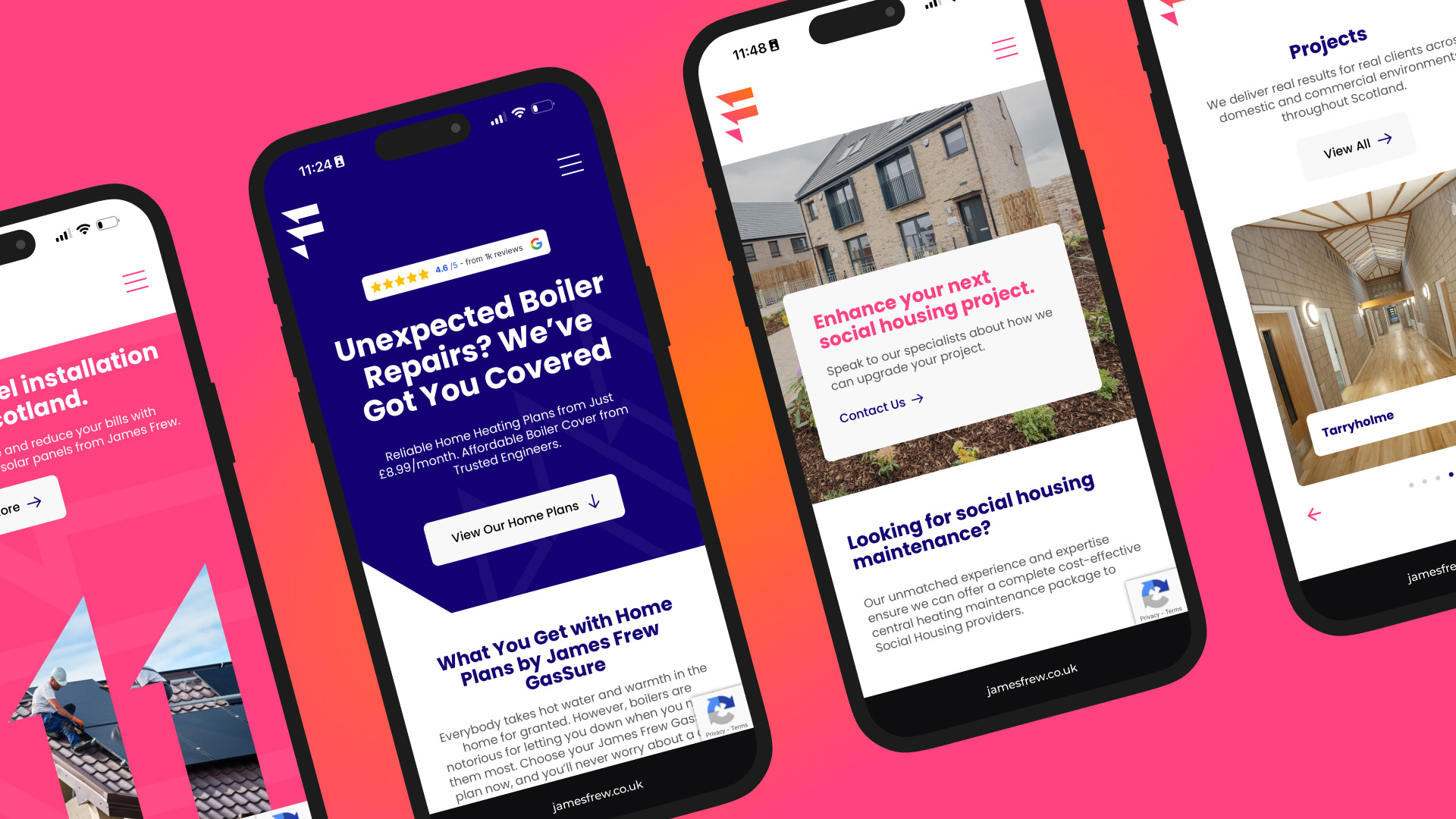What is the difference between website design and development?
Written by Lynsey Campbell
Introduction.
You’ve been quoted £5,000 for a “website build” – but what exactly are you paying for? Here’s the thing: most business owners don’t realise they might be hiring the wrong person entirely. Imagine you hire someone to create your dream website, only to discover they can make it look brilliant but can’t actually make the contact form work.
Think you need both a web designer and a web developer? Maybe not. Let’s clear up the confusion once and for all.
Here’s what we’ll cover:
- The actual difference between web designers and web developers
- Quick test: Do you need a designer, developer, or both?
- The accessibility checklist neither should ignore
- Red flags that scream “wrong hire”
We get it – tech speak is a pain.
That’s why at Scoot, we speak plain English and handle both web design and web development under one roof. No juggling freelancers or translating between teams.
TL;DR: the complete comparison.
| Aspect | Web designer | Web developer |
|---|---|---|
| What they do | Create visual layouts, choose colours, design user journeys | Write code, build functionality, manage databases |
| Focus area | How it looks and feels | How it works and performs |
| Key skills | UX principles, typography, creating and applying visual styles | HTML/CSS/JavaScript, backend languages, API integration |
| Tools used | Figma, Sketch, Adobe XD | VS Code, GitHub, Chrome DevTools, frameworks |
| You need them when… | Site looks dated, poor user experience, brand refresh needed | Need booking systems, ecommerce platforms, slow loading, broken features |
| Accessibility duties | Colour contrast, font sizes, visual hierarchy | Semantic HTML, keyboard navigation, ARIA labels |
| Red flags | Won’t review existing site, mobile costs extra, no user questions | No version control, can’t explain clearly, platform snobbery |
Bottom line:
Designers = visual aspects. Developers = technical aspects. Your website needs both. If you’re planning a new fully functional website that actually looks good, we recommend budgeting anywhere from £3,000 upwards for a future-focused solution.
Differences between website design and development.
Web designers create what you see. Web developers make it work.
That’s the simplest way to put it.
Web designer: the visual architect.
A web designer focuses on the look and feel of your web design. They’re obsessed with making sure visitors don’t bounce off your home page in horror.
What they actually do:
- Plan user journeys (where people click and why)
- Create mockups and wireframes (rough sketches that help plan your website layout)
- Choose colour schemes that won’t make your eyes bleed
- Select fonts that match your brand personality
- Ensure mobile layouts that keep users engaged on smaller screens
- Build style guides to keep everything consistent
- Tools they use: Figma (our favourite!), Adobe Creative Suite, Sketch
Full stack developer: the technical builder.
Here’s where web developers differ from their web designer counterparts – they take those visual elements and use their technical skills to turn them into a functioning website. They speak in code – literally.
What they actually do:
- Write HTML, CSS, JavaScript (the building blocks), and other coding languages that will make your website work
- Connect databases so your contact forms actually send emails
- Make sure pages load faster than you can say “bounce rate”
- Set up content management systems (like WordPress)
- Implement payment gateways that keep your customers’ data safe
- Fix bugs when things need tweaking
- Handle hosting and domain setup
- Ensure your site works on every browser (yes, even Internet Explorer)
- Tools they live in: VS Code, GitHub, Chrome DevTools, various frameworks like React or WordPress
The grey area: where lines blur.
Here’s where it gets messy. Some professionals wear both hats:- UX/UI designers – They design with development in mind. They know what’s possible to build and design accordingly.
- Front-end developers – The unicorns who code AND have an eye for design. They handle the visual coding aspects of the user interface (what users interact with).
- Full-stack developers – Jack of all trades who can design, develop and probably make you a coffee while they’re at it.
Quick reality check.
Many “web designers” you’ll meet today know some code. Most developers have some design sense.
But asking a pure designer to set up your ecommerce platform payment system is like asking a painter to rewire your house.
Could they figure it out? Maybe. Should you risk it? Absolutely not.
The James Frew website we built at Scoot? That needed both web design and development working in harmony – striking visuals for the users, plus complex functionality for API integration and smooth operational flow.

So, do I need a web designer or a web developer?
Stop second-guessing yourself. Answer these questions and you’ll know exactly who to hire.
You need a web designer if…
Your website problems sound like this:
- “It looks like it was built in 1995”
- “People can’t find what they’re looking for”
- “Our competitors’ sites look so much better”
- “The user interface feels clunky”
- “It doesn’t match our brand anymore”
Website designers focus on solving these visual and usability nightmares.
They’ll sort out other visual elements, from hero images to button styles. A successful web designer transforms confused visitors into happy customers through smart visual design.
You need a web developer if…
Your wishlist includes:
- “I want customers to book appointments online”
- “We need a members-only area”
- “The site takes ages to load”
- “Our forms don’t actually send emails”
- “I want to sell products directly”
This is where web developers play their part.
They’ll handle the complex programming languages needed to make these features work. Whether it’s writing code for a booking system or integrating payment gateways, they live for this stuff.
The skill breakdown.
Here’s how designers and web developers typically divide their technical expertise:
| Visual designer toolkit | Average web developer arsenal |
|---|---|
| Colour theory and typography | HTML, CSS, JavaScript (the basics) |
| User experience mapping | Advanced programming languages (PHP, Python, Ruby) |
| Brand identity creation | Database management |
| Responsive design principles | API integrations |
| Prototyping and wireframing | Security protocols |
But here’s the catch:
Web developers specialise in different areas. Some handle only the parts you see (front-end), others work on behind-the-scenes functionality (back-end). Similarly, you’ll meet different types of web designers too – some focus purely on aesthetics, others on user experience.
The real question isn’t just “designer or developer?” It’s “which type of designer or developer?”
Your three options
- Hire separately – Get a designer for mockups, then a developer to build. Works well if you love project management.
- Find a unicorn – Someone skilled in both.
- Work with an agency – Like Scoot, where designers and web developers collaborate daily. You get both skills without the headache of coordination.
The 30-second decision maker
- Just need a facelift? Web designer.
- Just need functionality? Web developer.
- Need a brand new functional website or fixing something broken? You’ll need both.
The accessibility checklist you shouldn't ignore.
Accessibility isn’t optional – it’s the law. Both web designers and web development specialists need to nail this, or your site excludes 20% of potential customers.
Designer accessibility duties
The web designer’s job includes making visual aspects work for everyone. This includes:
- Colour contrast ratios of at least 4.5:1 for normal text
- Clear visual hierarchy so screen readers understand your content structure
- Alt text spaces in designs for every image
UI designers must think beyond making things visually appealing. Can someone with colour blindness tell your error messages from the success ones?
Developer accessibility duties
Web developers build the technical framework that makes accessibility real:
- Semantic HTML that tells screen readers what’s what
- Keyboard navigation so every feature works without a mouse
- ARIA labels for complex custom web applications
Skip links to jump past repetitive navigation
Back-end developers handle form validation messages and error handling. Front-end development includes focus states and proper heading structures.
The overlap zone
Here’s where web designers work with developers:
- Testing with real accessibility tools
- Ensuring the site functions smoothly for keyboard users
- Checking the website’s appearance at 200% zoom
- Validating colour choices in real browsers
Search engine optimization loves accessible sites, too. Google rewards a clear core structure and proper semantic markup. It’s a win-win that neither role can achieve alone.
Red flags to keep an eye out for.
Run for the hills if you spot these warning signs. Take it from us, we’ve heard them all and know how to spot them from a mile off.
Universal red flags
- No contract or unclear pricing
- Won’t provide references or portfolio pieces
- Promises unrealistic timelines
- Defensive about past work
- “Trust me, I know what’s best” attitude
Remember, building websites requires collaboration. If they’re difficult during the sales process, imagine working with them for months.
Designer red flags
- “I don’t need to see your existing website.” Any designer who won’t review your current site is designing in a vacuum. They should analyse what’s working (and what isn’t) before touching prototyping tools.
- “Mobile design costs extra.” It’s 2025. If they’re not designing mobile-first, they’re stuck in the dark ages. Every quote should include responsive design as standard.
- “I’ll make it pretty first, then we’ll figure out functionality.” The site’s layout and interactive features must work together from day one. Pretty but broken helps nobody.
- Zero questions about your users: UX designers obsess over user behaviour. If they’re not asking who visits your site and why, they’re just decorating, not designing.
Developer red flags
- “I don’t use version control systems.” This is like a chef not washing their hands. Git isn’t optional – it’s how professionals build and maintain websites safely.
- Can’t explain their process in plain English. Yes, back-end web developers work with complex coding languages. But if they can’t explain what they’re building without jargon, communication will be a nightmare.
- “WordPress is for amateurs.” Snobbery about platforms shows inexperience. A good software developer uses the right tool for the job, not the fanciest one.
- No testing environment. They want to make changes to your actual website? That’s like performing surgery in your living room. Professionals test everything offline first.
Get web designers and web developers in one perfect partnership with Scoot.
So there you have it – designers make it look brilliant, developers make it work brilliantly. Most projects need both to work in harmony. Choose based on your actual needs, not assumptions.
Key takeaways:
- Designers handle visuals and user experience
- Developers manage functionality, databases and technical features
- Budget a minimum of £3,000+ for a professional UK website
- Both must prioritise accessibility – it’s not optional
- Watch for red flags: no portfolio, unclear pricing or poor communication
- Consider agencies when you need both skills under one roof
At Scoot, we’ve taken the guesswork out of this decision. Our designers and developers collaborate daily on everything from simple sites to complex platforms. No web designers vs developers here – just one straightforward partnership.
Still confused about what you need? Book a free 30-minute discovery call with Scoot. We’ll help you figure out exactly what your website needs to succeed.
Latest insights.
Stay connected with Scoot. Read the latest insights from our team on the industry, the studio and what we’re delivering for our clients.


